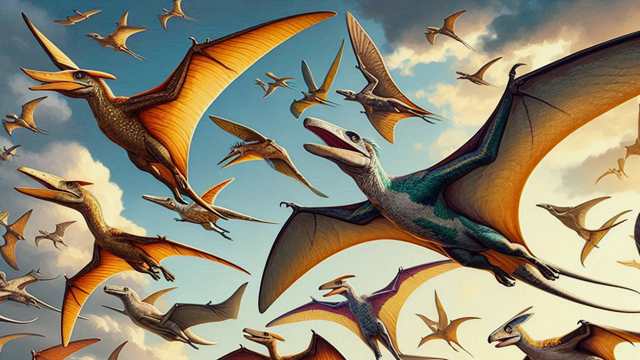Pterosaurs, the powerful flying reptiles that ruled the skies from the Jurassic to the Cretaceous period, have captivated scientists and enthusiasts for decades. These creatures, with their impressive wingspans and distinct lack of feathers, thrived in coastal environments, hunting fish and other marine life. Their unique wing structure, supported by an elongated fourth finger, and hollow limb bones allowed them to achieve true flight, unlike modern birds.
Despite their ancient lineage and presumed extinction 65 million years ago, reports of pterosaur-like creatures have persisted into modern times. Sightings and encounters span across continents, particularly in the dense swamps and remote areas of Africa. Could these legendary creatures still be soaring above us, or are these tales simply myths and misidentifications?
Table of contents
The Pterosaur Phenomenon
The energy required for sustained flight and the need for regulating body heat suggest that pterosaurs had some form of thermoregulation. While they may not have been warm-blooded like mammals, their ability to remain airborne for extended periods indicates advanced adaptations. Most pterosaur species ranged from the size of a sparrow to that of an eagle, but some, like the Pteranodon and the colossal Quetzalcoatlus, boasted wingspans of 27 to 50 feet.
Despite their impressive features, the survival of pterosaurs into the present day seems implausible. However, reports of sightings and even attacks by pterosaur-like creatures have emerged over the years, particularly from Africa.
African Encounters: The Kongamato
In 1923, Frank H. Melland, a traveler in Zambia, documented native accounts of a ferocious flying reptile known as the Kongamato, which translates to “overwhelmer of boats.” According to locals, this creature inhabited the Jiundu swamps in western Zambia and had a wingspan of 4 to 7 feet, smooth black or red skin, and a beak full of teeth. The Kongamato was notorious for capsizing canoes and causing death to those who encountered it.
When shown illustrations of pterosaurs, the natives identified them as Kongamato without hesitation. This included a headman from the Jiundu country, where the creature was reportedly most active.
More Strange Encounters
In 1925, English newspaper correspondent G. Ward Price, accompanied by the future Duke of Windsor, reported a story from Rhodesia (now Zimbabwe). A man who ventured into a feared swamp returned with a severe chest wound, claiming he was attacked by a giant bird with a long beak. When shown a picture of a pterosaur, the man reacted with terror, reinforcing the connection between his attacker and the ancient reptiles.
In 1942, Colonel C. R. S. Pitman gathered reports from Northern Rhodesia (Zambia) of a large bat-like creature inhabiting the swamps. Evidence included tracks with large tail drags, suggesting a substantial creature.
Western Encounters: The Olitiau
In 1932-1933, the Percy Sladen Expedition, led by zoologist Ivan T. Sanderson, ventured into West Africa. While hunting near a river in the Assumbo Mountains, Sanderson and his companion encountered a black, eagle-sized creature with a semicircle of pointed teeth. The natives identified it as the Olitiau, a feared bat-like creature.
Modern Sightings
In 1956, engineer J.P.F. Brown reported seeing two prehistoric-looking creatures with wingspans of 3 to 3.5 feet and elongated snouts flying over Zambia’s Luapula River. A year later, a patient in a nearby hospital claimed to have been attacked by a similar creature, sketching a pterosaur-like figure.
In 1988, Professor Roy Mackal led an expedition to Namibia, where reports of a 30-foot wingspan creature emerged. Although no solid evidence was found, team member James Kosi described seeing a giant glider-shaped, black creature with white markings.
Possible Explanations
Skeptics argue that these sightings may stem from misidentifications or local folklore. The shoebill stork, a large, dark bird with an 8-foot wingspan, and the saddle-billed stork, with its distinct coloration and pointed beak, could be mistaken for pterosaurs, especially in low light conditions.
While these birds do not match all descriptions of the Kongamato or Olitiau, their presence in the same regions offers a plausible explanation for some reports. Additionally, the superstitions and imaginations of locals may amplify these sightings into tales of flying monsters.
The Mystery Persists
Despite numerous eyewitness accounts, no concrete evidence supports the existence of living pterosaurs. Encounters often occur in remote, inaccessible regions, making verification difficult. Africa’s dense swamps and hostile terrain, coupled with political instability, create significant obstacles for thorough exploration.
For now, the legend of the Kongamato and other pterosaur-like creatures remains a tantalizing mystery. Whether they are remnants of a prehistoric past or merely products of human imagination, the fascination with these flying reptiles continues to captivate and intrigue.
As science advances and exploration technologies improve, perhaps one day we will uncover the truth behind these ancient legends. Until then, the skies above Africa hold their secrets close, leaving us to wonder if the mighty pterosaurs are still among us.

